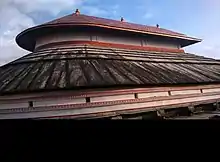Anantheshwara Temple, Udupi
Udupi Anantheshwara Temple is a historic Hindu temple dedicated to Lord Shiva The Anantheshwara temple is located in Udupi, India. The temple is a unique temple where Shiva is worshipped in the form of Linga.[1][2] Writer Roshen Dalal says, "According to texts, the city formed part of Parashurama Kshetra, the area is said to be claimed by Parashurama from the sea. Legends state that a king name Ramabhoja worshipped Shivalinga here in the form of Linga, which then manifests itself on a silver seat (rajata pitha). Thus in Sanskrit texts, the city is known as Rajata Pitha".[3] There's also a belief that the temple was built by Pandavas
| Anantheshwara Temple of Udupi | |
|---|---|
 | |
| Religion | |
| Affiliation | Hinduism |
| District | Udupi district |
| Deity | Lord Shiva |
| Location | |
| Location | Udupi |
| State | Karnataka |
| Country | India |
| Architecture | |
| Type | Kerala temple architecture |
| Creator | Alupas |
| Completed | 8th century C.E. |
| Website | |
| Shri Anantheswara temple | |
The temple was renovated during the reign of the Alupas in the 8th century C.E. and is considered among the oldest in the Tulu Nadu region. Ananteshwara Temple of Lord Shiva is close to Chandramouleshwara Temple of Lord Shiva.
The temple is the oldest in Udupi managed by Puttige Matha, one of the Ashta Mathas of Udupi.[4][5][6]
References
- G. Kameshwar (2004). Tulu Tales: A Soota Chronicle. Rupa & Company. p. 31. ISBN 9788129104274.
The association of Parasurama worshipped shivalinga here and the place of worship is the present Anantheshwara temple.
- "Steeped in history, the region is a pilgrim's delight". The Hindu. Retrieved 18 April 2015.
- Roshen Dalal (18 April 2014). Hinduism: An Alphabetical Guide. Penguin UK. p. 1267. ISBN 9788184752779.
- "Udupi: Internal differences between Swamijis of eight Maths pour out into open". Daijiworld News. 10 June 2015.
- Keshavadas (1972). The Doctrine of Reincarnation and Liberation. Dasashrama Research Publications. p. 77.
It also creates awe and wonder to know that Madhwa disappeared in the air from Udipi Ananteshwara Temple while he was lecturing on the Aitaraya Upanishad which is why it is known that he was the incarnation of the wind god.
- C. Panduranga Bhatta; G. John Samuel (1997). Contribution of Karaṇāṭaka to Sanskrit. Institute of Asian Studies. p. 352.